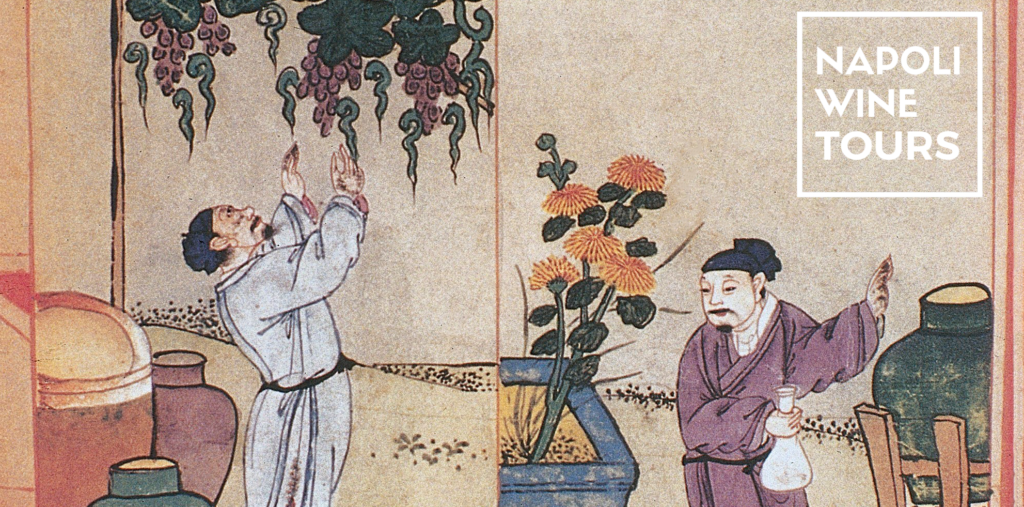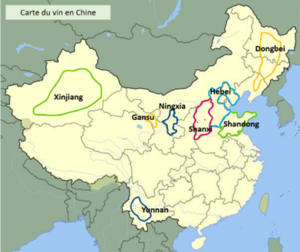
Today we certainly go beyond regional, national, and even European borders.
So much is said about Chinese wines, and to judge you have to taste them. So here we are ready, but as always we do it by contextualizing and deepening the history of Chinese wine and the current conditions of production.
China is a place of gastronomy and traditions, and wine has managed to carve out a place in the local culture. Furthermore, the history of grape cultivation is ancient in the Middle Kingdom, but its development is very recent, and the country is still young in terms of wine know-how and culture. The first traces of the wine culture in China date back to the 1st and 2nd centuries BC, it was introduced through Central Asia and for centuries this culture will remain endemic. Grapes will often be mixed with other drinks to create local drinks, made up of different fruits. In fact, we start from the Chinese alcoholic drink jiu which is translated with the term “wine”, but which is not wine since it refers to an alcoholic drink made from fermented cereals (millet, wheat, and rice).
It was only in 1922 that the first winery in China was created. This creation was the result of a collaboration with the USSR, which also allowed the introduction of new vines from Eastern Europe, mainly from Bulgaria and Romania. During this period, the vineyard developed considerably in China, which until then had mainly produced sweet wines, very sweet and always mixed with other fruits and spices.
We have come to today and we discover that in 2016, China had the 2nd largest vineyard in the world with 875,000 hectares, behind Spain and ahead of France. It is the 1st world producer of grapes (19% of production) and the 6th world producer of wine. Collaborations and acquisitions with and by European wineries are innumerable and production is reaching high-quality levels.
Chinese wine regions are distributed throughout the country, although they are mainly located in Shandong, Hebei, Xingiang, Ningxia, Dongbei and Gansu;

Let’s move on to the tasting. We tasted 2 wines from Château Changyu Moser XV. They come from the Helan Mountain district of Ningxia, a region promoted by the government as the heart of quality wine production. We are in the center of the country, in a desert area protected by the mountain range to the west; the climate is continental, with harsh winters and scarce rainfall (180 / 200mm / year), high diurnal excursion, and excellent exposure to the sun. The company was born from a joint venture between the Moser family of Austrian winemakers and Changyu Pioneer, the leading Chinese producer group in terms of quantity.
Château Changyu Moser XV, Cabernet Sauvignon 2018, Blanc de Noir, 13.5
The company presents this Cabernet Sauvignon vinified in white as the first in the world, for us it was certainly the first taste of this type of wine. A wine that surprised us in various aspects: from the color to the unexpected smell.
Color: pale pink, slightly coppery (looks like a Provençal rosé)
In the nose: the first notes are sweet, almost of custard (therefore a fearful approach to the glass), ripe fruit, confit tomatoes, light citrus fruit of kumquat, then there are vegetal notes of tomato leaf. Amazement is all there …
Taste: the SURPRISE! From the nose we expected a sweet wine, instead, it is dry, taut, with a wide freshness. The flavor is not excessive, the alcohol is well balanced with the other tactile sensations. The aromas to the taste become more incisive in the range of vegetables and the cabernet sauvignon is recognizable all. Persistent and balanced, it is a pleasant wine both to drink as an aperitif at a temperature of 7-8 ° and throughout the meal with a few degrees more.
Notes: combined with a plate of grilled swordfish and octopus alla giudea it was perfect! Less successful is the combination with stuffed zucchini flowers (in which the filling had an excessive PAI)
Château Changyu Moser XV, Cabernet Sauvignon 2017, 14.5
This tasting also surprised us very much, since wanting to find a simplifying metaphor, this wine is a Wrestler! One of those who take a run and jumps on you! It does not undergo aging in wood, and the hot/desert climate of the region is found all in the glass.
Color: intense ruby red
Nose: Green pepper! From the textbook, but also notes of black cherry, and undergrowth, and a light ethereal that increases with oxygenation. It does not have a wide range of aromas,
Taste: sharp tannins, little freshness and a lot of alcohol make the sip immediately challenging. The fresh tobacco leaf takes the place of the green pepper, the licorice stick and a toasted note leave us perplexed as it has not made the passage in wood.
Notes: a wine that must be paired with a dish of great structure and PAI.
For us, this tour among the vineyards of the rising sun was a continuous surprise, and we hope to have intrigued you, we are waiting for you to taste them together. For info contact us here.
